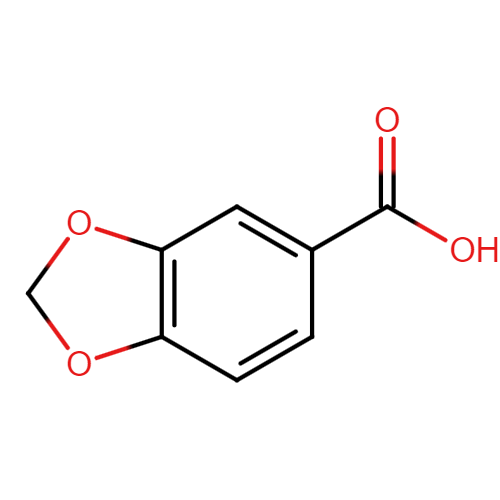3,4-Methylenedioxybenzoic acid
| Compound Structure: |

|
||||||||||||||||||||||||||||||||||||||||||
|---|---|---|---|---|---|---|---|---|---|---|---|---|---|---|---|---|---|---|---|---|---|---|---|---|---|---|---|---|---|---|---|---|---|---|---|---|---|---|---|---|---|---|---|
| Synonyms: | PIPERONYLIC ACID;94-53-1;1,3-Benzodioxole-5-carboxylic acid;Benzo[d][1,3]dioxole-5-carboxylic acid;Heliotropic acid;3,4-Methylenedioxybenzoic acid;Protocatechuic acid methylene ether;benzo[1,3]dioxole-5-carboxylic acid;3,4-(Methylenedioxy)benzoic acid | ||||||||||||||||||||||||||||||||||||||||||
| Compound ID: | NMPC-312 | ||||||||||||||||||||||||||||||||||||||||||
| PubChem ID: | |||||||||||||||||||||||||||||||||||||||||||
| Molecular Formula: | C8H6O4 | ||||||||||||||||||||||||||||||||||||||||||
| Canonical SMILES: | C1OC2=C(O1)C=C(C=C2)C(=O)O | ||||||||||||||||||||||||||||||||||||||||||
| InChIKey: | VDVJGIYXDVPQLP-UHFFFAOYSA-N | ||||||||||||||||||||||||||||||||||||||||||
| About the compound: | Piperonylic acid, also known as piperic acid, is a chemical compound belonging to the class of benzodioxoles. It is characterized by a 1,3-benzodioxole structure substituted by a carboxy group at position 5. Here are some key points about piperonylic acid: Piperonylic acid is a natural product found in several plant species, including Nectandra amazonum and Pongamia pinnata var. pinnata. Biological Activities: Piperonylic acid exhibits several interesting biological activities. It is known as a selective mechanism-based inactivator of the trans-cinnamate 4-hydroxylase enzyme. This property makes it useful in inhibiting certain enzymatic reactions. Piperonylic acid has been found to possess antifungal properties, which means it can help inhibit the growth or development of fungi. The compound is also associated with skin wound healing, indicating its potential use in the treatment of skin injuries or wounds. Piperonylic acid can be synthesized and is often obtained by the base-hydrolysis of the alkaloid piperine, which is found in black pepper. This base-hydrolysis is followed by the acidification of the corresponding salt. Piperonylic acid is used as an intermediate compound in the synthesis of other substances, including fragrances, perfumes, flavorants, and drugs. Piperonylic acid is a monocarboxylic acid and an aromatic carboxylic acid. It can act as a conjugate acid of piperonylate. Due to its natural occurrence and diverse range of applications, piperonylic acid is a compound of interest in various fields, including chemistry, biochemistry, and pharmacology. Researchers continue to explore its properties and potential uses in different applications. GHS Hazard Statements • H302 (89.13%): Harmful if swallowed [Warning Acute toxicity, oral] • H315 (95.65%): Causes skin irritation [Warning Skin corrosion/irritation] • H318 (84.78%): Causes serious eye damage [Danger Serious eye damage/eye irritation] • H319 (15.22%): Causes serious eye irritation [Warning Serious eye damage/eye irritation] • H335 (100%): May cause respiratory irritation [Warning Specific target organ toxicity, single exposure; Respiratory tract irritation] |
||||||||||||||||||||||||||||||||||||||||||
| Properties: |
Chemical
and Physical Properties
Source: PubChem |
||||||||||||||||||||||||||||||||||||||||||
| Source Species: |
Crassocephalum rubens |